The Intel Haswell-E CPU Review: Core i7-5960X, i7-5930K and i7-5820K Tested
by Ian Cutress on August 29, 2014 12:00 PM ESTCPU Benchmarks
The dynamics of CPU Turbo modes, with both Intel and AMD, can cause concern during environments with a variable threaded workload. There is also an added issue of the motherboard remaining consistent, depending on how the motherboard manufacturer wants to add in their own boosting technologies over the ones that the CPU manufacturer would prefer they used. In order to remain consistent, we implement an OS-level unique high performance mode on all the CPUs we test which should override any motherboard manufacturer performance mode.
HandBrake v0.9.9: link
For HandBrake, we take two videos (a 2h20 640x266 DVD rip and a 10min double UHD 3840x4320 animation short) and convert them to x264 format in an MP4 container. Results are given in terms of the frames per second processed, and HandBrake uses as many threads as possible.
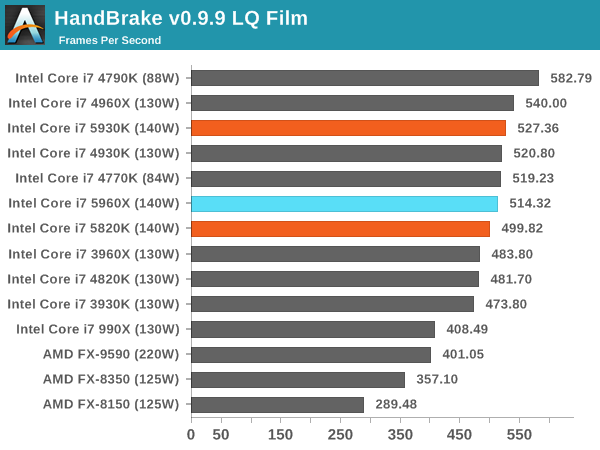
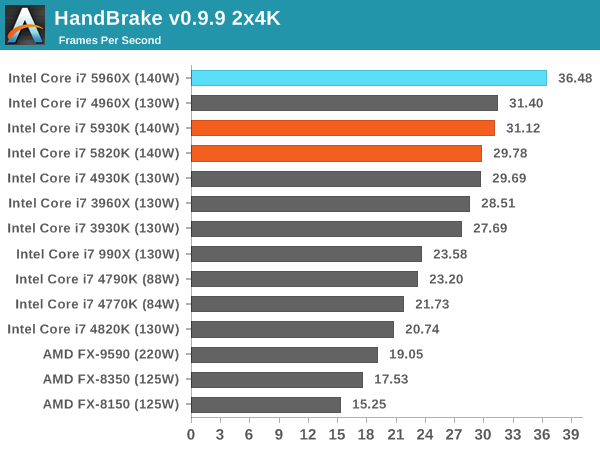
The variable turbo speeds of the CPUs results in a small difference in low quality conversion, and the high single core frequency of the 4790K wins there. For 4K conversion the problem becomes more parallel and the extra cores of the 5960X push it ahead of the pack. The 5930K and 5820K are both behind the 4960X however.
Agisoft Photoscan – 2D to 3D Image Manipulation: link
Agisoft Photoscan creates 3D models from 2D images, a process which is very computationally expensive. The algorithm is split into four distinct phases, and different phases of the model reconstruction require either fast memory, fast IPC, more cores, or even OpenCL compute devices to hand. Agisoft supplied us with a special version of the software to script the process, where we take 50 images of a stately home and convert it into a medium quality model. This benchmark typically takes around 15-20 minutes on a high end PC on the CPU alone, with GPUs reducing the time.
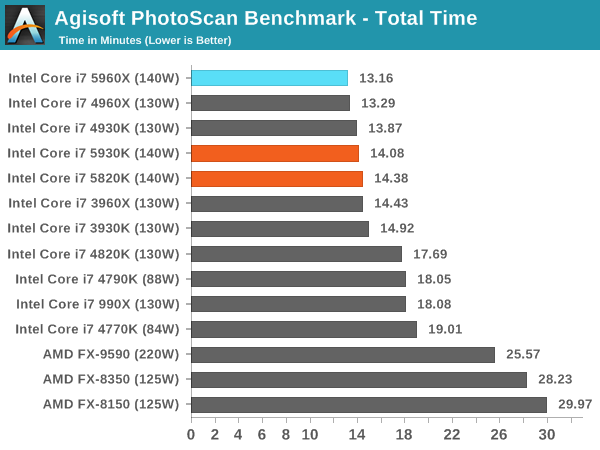
Photoscan's four separate components rely on different amounts of high frequency vs. many cores: check our Bench database for more detailed results but overall the 5960X comes out on top. That being said, the 5820K is less than 40% of the price and is only 1.2 minutes behind.
Dolphin Benchmark: link
Many emulators are often bound by single thread CPU performance, and general reports tended to suggest that Haswell provided a significant boost to emulator performance. This benchmark runs a Wii program that raytraces a complex 3D scene inside the Dolphin Wii emulator. Performance on this benchmark is a good proxy of the speed of Dolphin CPU emulation, which is an intensive single core task using most aspects of a CPU. Results are given in minutes, where the Wii itself scores 17.53 minutes.
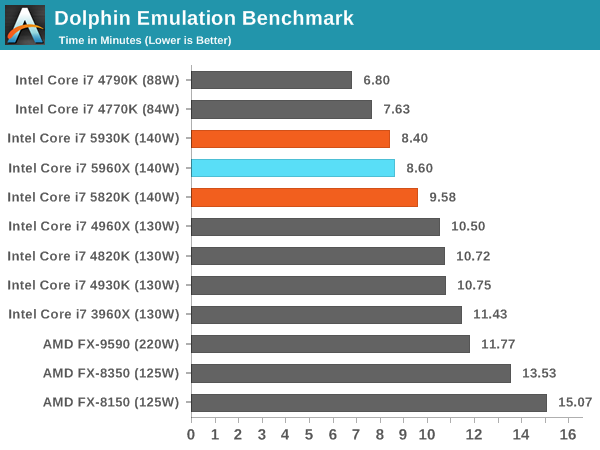
Dolphon loves single core speed and efficiency, meaning the 4790K wins out again. Interestingly the large L3 cache of the 5960X also helps here against the 5820K, despite the 5820K having a higher single thread frequency.
WinRAR 5.0.1: link
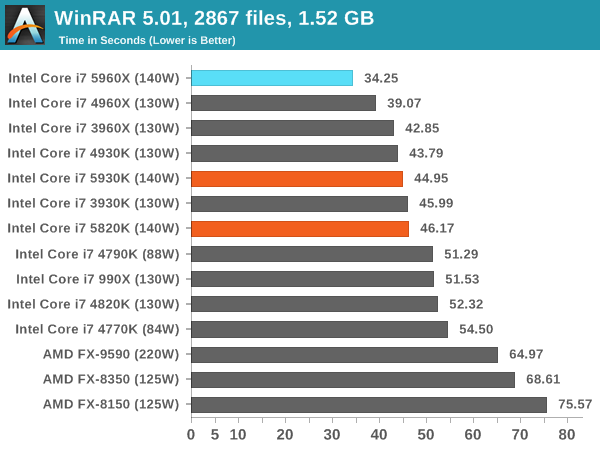
WinRAR is a variable thread workload, but more cores still wins out. Interestingly the xx60X CPUs are ahead of the xx30K CPUs followed by the xx20K. After this comes the 4790K, and then the 990X on par, showing how far three generations of Intel CPU have developed.
PCMark8 v2 OpenCL
A new addition to our CPU testing suite is PCMark8 v2, where we test the Work 2.0 and Creative 3.0 suites in OpenCL mode.
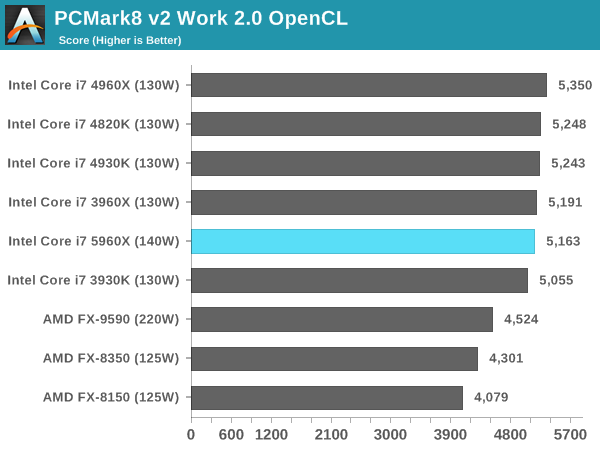
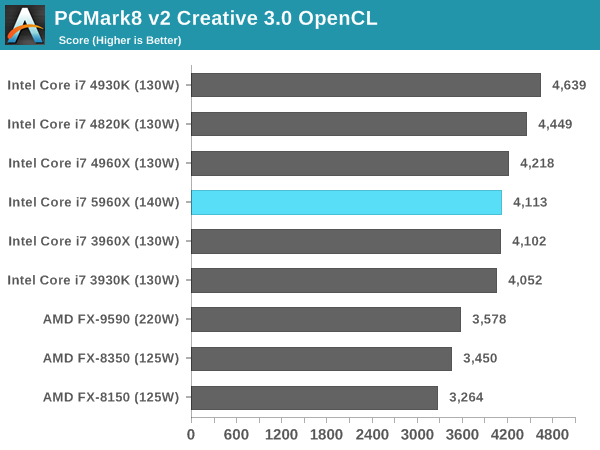
PCMark v8 relies on a number of factors, and it would seem that frequency is preferred over cache and memory. Interestingly the 4930K beat the 4960X in the Creative Suite with no obvious explanation.
Hybrid x265: link
Hybrid is a new benchmark, where we take a 4K 1500 frame video and convert it into an x265 format without audio. Results are given in frames per second.

Converting 4K video gets another step in the preference for more cores in Hybrid x265. The 5820K matches the 3960X, showing the progression of CPU generational development.
Cinebench R15
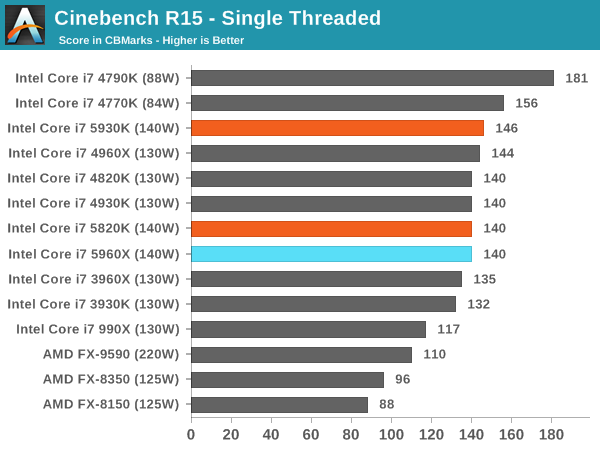
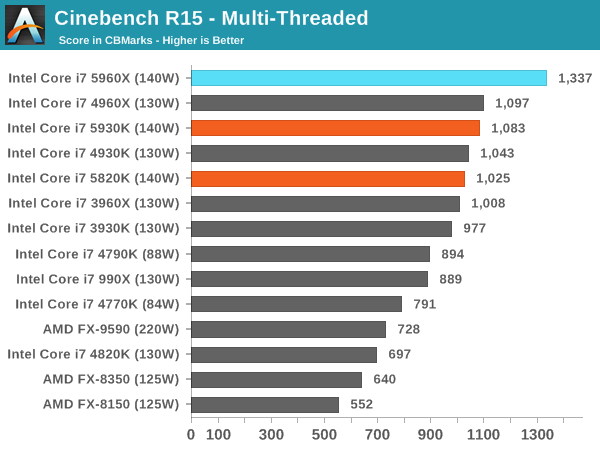
3D Particle Movement
3DPM is a self-penned benchmark, taking basic 3D movement algorithms used in Brownian Motion simulations and testing them for speed. High floating point performance, MHz and IPC wins in the single thread version, whereas the multithread version has to handle the threads and loves more cores.
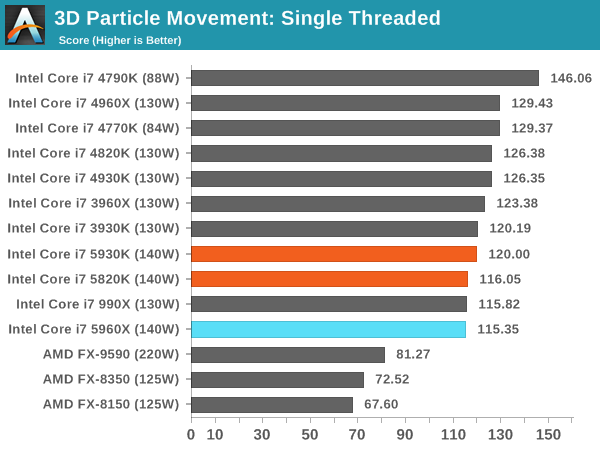

FastStone Image Viewer 4.9
FastStone is the program I use to perform quick or bulk actions on images, such as resizing, adjusting for color and cropping. In our test we take a series of 170 images in various sizes and formats and convert them all into 640x480 .gif files, maintaining the aspect ratio. FastStone does not use multithreading for this test, and results are given in seconds.
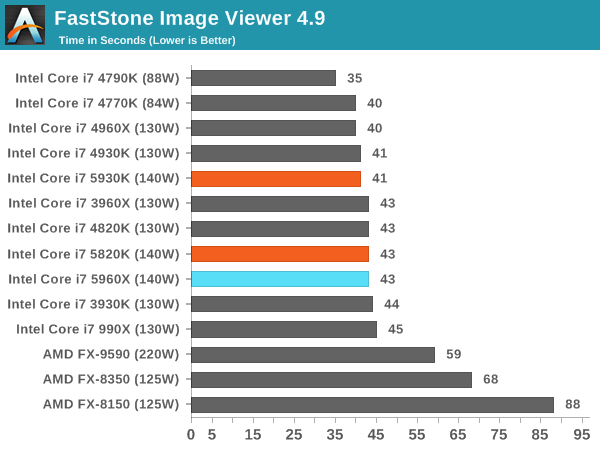
FastStone is a purely single threaded exercise, showing here how the lower core CPUs with high turbo perfom best, and by quite a margin.










203 Comments
View All Comments
NeatOman - Friday, August 29, 2014 - link
Sooo... its good for very high end gaming and rendering.Motion2082 - Friday, August 29, 2014 - link
Hey guys, I'm running a i7 2600k on ME4Z @ 4.8GHz. My system is fast enough for most applications, only struggles with multiple applications running. Should I be looking at Haswell-E or waiting until Broadwell? Only annoyance I have with i7 2600k is slow video encoding and restrictions on multi-tasking.TeXWiller - Saturday, August 30, 2014 - link
Adjust manually your process priorities and core affinities, if necessary. The old work horse will take you a lot longer still. I may have a 14-hour rendering process going with fully loaded cores and still run a nice FPS session at will, provided that I adjust the process priority manually.mapesdhs - Saturday, August 30, 2014 - link
What is your RAM speed? I find 2133 @ CL10 to be optimal with the M4E/Z (I have
five of those boards, all with 2700Ks @ 5.0).
Make sure you have a good SATA3 SSD to exploit the Intel SATA3 port. Don't use
the Marvell ports. An H80i with NDS fans works really well for low-noise, but even an
old TRUE with any two decent fans will happily run a 2700K @ 5.0 (I've used the
TRUE, TRUE Black, VenomousX, Phanteks, etc., but recently bought a whole pile of
refurb H80s for a good price).
If you want an intermediate upgrade, get a used 3930K C2, a good used X79 board
(I keep buying the ASUS P7X79 WS, done five so far), move over your RAM, etc.
Note the same caveats re Intel/Marvell ports, use an H100i + NDS fans instead, and
voila, you're up & running away with a 6-core for not much outlay. A recent build I did
empllyed a 3960X which cost 245 UKP, the above ASUS board for 190 UKP, etc.
Gave 1221 for CB R15, while your 2600K @ 4.8 should give around 850, so that's a
very nice bump for threaded tasks and running multiple apps in general.
I suggest an 840 Pro or 850 Pro for an SSD, though there are lots of used bargains
available. I bagged a 512GB Vector for 160, ideal as a cache for AE, while an OEM
840 Pro was only 87. Best of all, I keep getting 1475W Thermaltake Toughpower XT
Gold units for around 125 UKP (less than half normal new cost), perfect for handling
four heavy GPUs for CUDA or whatever (my system has four GTX 580 3GB atm) in
an oc'd 6-core system with multiple SSDs, RAID, etc.
More references, examples & suchlike available on request - don't want to clog this thread.
Ian.
LordHaHa - Friday, August 29, 2014 - link
Mixed feelings on this one. This is a solid effort here, and the 5820K at around $390 is potentially interesting, seems very similar to the 3930K and it's a bit cheaper by default.That said, I don't see much of a reason to upgrade from SB-E or IB-E if you already have something in that. Certainly even the 5820K is a bit overkill for gaming for the price.
I do have to say we live in strange times where even latter-day Core 2 systems (paired with very good video cards, as a caveat) are still fairly capable for most single player gaming environments; certainly they can still handle any casual task thrown at them. And anyone who's got to Sandy Bridge has had little reason to upgrade their systems yet, for sure. Ten years ago, saying "I have no reason to upgrade my 2-4 or so generation old box" would have been crazy talk.
Laststop311 - Friday, August 29, 2014 - link
Very impressed with the 8 core overclock. I was worried that having such a low stock meant the oc wouldn't be too good. They had it on a crappy closed loop 140mm rad and it did well. I have a custom loop that cools the motherboard chipset and vrm, the cpu, and the gpu. A triple 5.25" reservoir with dual mcp 655 pumps in series at setting 4 1 below max pump speed a 60mm thick 420mm rad with 6x 140mm noctua a15 fans in push pull. Hopefully I can hit 4.8ghz i'll be very happy but as long as i can hit 4.5ghz ill be satisfied. I'm coming from a 4261mhz i7-980x so this is going to be a rly big upgrade for my video work and even a noticeable boost in gaming not huge but noticeable.I'm totally pleased with the i7-5960x. Waited 3 generations from nehalem to upgrade. With haswell-e ill be waiting at least 4 possibly 6 generations to upgrade unless some crazy new chipset geature makes me do it earlier.
cactusdog - Saturday, August 30, 2014 - link
I really wish they took the voltage regulator off the CPU. Its really a bit sad that a 4790K can beat this highend expensive chip in single threaded tasks. I was really looking forward to this but performance doesn't justify the cost unless you do a lot of multi threaded stuff. With skylake coming with PCI-E 4 this system is going to be outdated pretty quickly. One thing is for sure, the days of big overclocks on the CPU side are over.ToTTenTranz - Saturday, August 30, 2014 - link
The 28 lanes in the 5820k don't make much difference in SLI because it uses the SLI bridge as interconnect between the graphics cards.It would be interesting to see if the 16x/8x configuration makes any difference with two of the newer bridgeless Radeon cards.
Especially since the first build exemplified in this review uses that same configuration (5820k with two Radeon 285 cards).
mlambert890 - Monday, September 1, 2014 - link
there absolutely is *not* data going across the sli bridge at all. the only thing going across the bridge is timing and signaling info. it is a tiny 1GB/s interconnectat extremely high resolutions on pcie 2 SLI is where you specifically DO need more lanes. pcie 3 alleviates this. multi 4k would bottleneck again, but the best gpus can barely handle a single 4k in high detail anyhow even in tri-sli
fallaha56 - Saturday, August 30, 2014 - link
Hmm one last benchmark (emulation-related) I'd like to see (and suspect many others would too) -run PCSX2 in software mode with 8+ threads and see if there's benefits.Try something really tough like Shadow of the Colossus.
Looks like this chip is a man looking for a mission, is that it?